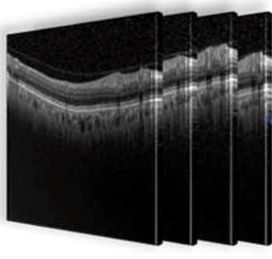Deep learning with multimodal data can predict imminent conversion to wet Age-Related Macular Degeneration
Team: Obsidian
- Program: Biomedical Engineering
- Course: Precision Care Medicine
Project Description:
Development of a deep learning framework that improves prediction of imminent conversion from the dry form to the wet form of age related macular degeneration using optical coherence tomography imaging.
Project Poster
Open full size poster in new tab (PDF)
Project Post Summary:
Age-related macular degeneration (AMD) is a disease affecting the macular region of the retina and the leading cause of vision loss in persons over the age of 50. Optical coherence tomography (OCT) imaging is used to diagnose and manage the disease, which can be categorized as dry- or wet-AMD. All patients start with dry AMD, but only some convert to the wet form. The latter is characterized by fluid leakage and the development of choroidal neovascularization underneath the retina, leading to central vision loss. The current standard of care for wet AMD is repeated intravitreal injections of anti-VEGF therapies, which can cost up to $2000 for each dose. Early intervention is crucial given that visual acuity at the start of treatment is an important predictor for treatment outcome and vision is precipitously lost following conversion. Currently, retinal specialists can only provide average risk estimates for conversion from dry to wet AMD over 5 years. Such average risk estimates are not ideal, as they are not fine-grained enough to provide meaningful, actionable information. To address this issue, we assessed the performance of a 3-dimensional neural network trained to predict conversion to wet-AMD within 6 months using nearly 28,000 OCT scans taken prior to conversion. We integrated the output of the neural network with clinical risk factors associated with conversion in two ways. First, we developed conventional machine learning models with the clinical features alone, which had low predictive power for conversion. Adding the image feature vector generated by the neural network as a predictor for these models increased AUC, but did not improve performance over the neural network alone. In our second approach, we concatenated the clinical features to the final feature vector of the neural network before applying a multi-layer perceptron network. This model performs just as well as the neural network with OCT scans below, and even better when predicting imminent conversion for patient’s first eyes. Overall, we have identified a deep learning framework that improves prediction of imminent conversion using OCT scans. In the future, this framework can be used to predict successful treatment response in an effort to improve treatment efficacy and reduce costs.
Project Mentors, Sponsors, and Partners
- Research to Prevent Blindness Career Development Award, Awarded to Alvin Liu
- Alvin Liu
- Craig Jones
- Yuxuan Liu
- Joseph L Greenstein
- Casey Overby Taylor



